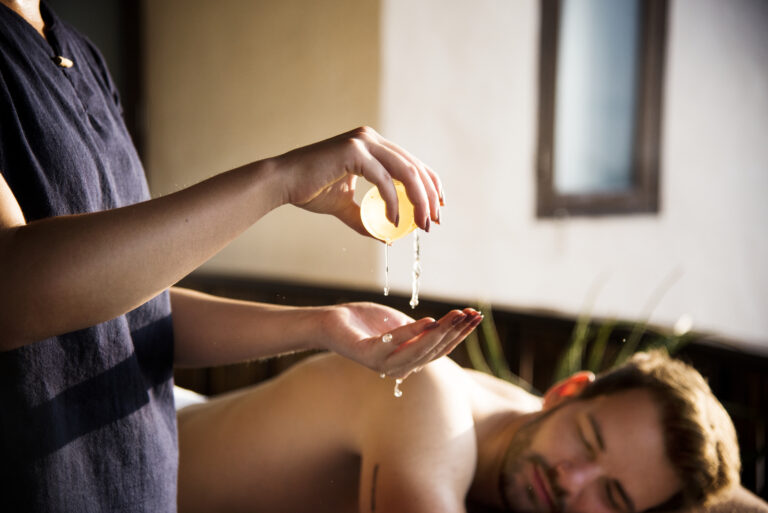
Full-body oil massages have been cherished for centuries as a powerful method of relaxation, healing, and rejuvenation. The soothing and therapeutic effects of these massages have made them a popular choice for those seeking to alleviate stress and promote overall well-being. In this ultimate guide, we’ll delve into the numerous benefits of full-body oil massages, such as improved Circulation, reduced muscle tension, and enhanced skin health. We will also explore the various techniques employed by professional therapists, including Swedish, deep tissue, and aromatherapy massages, each designed to address specific needs and preferences.
During a full-body oil massage session, you can expect a tranquil environment where soft lighting, calming music, and the gentle aroma of essential oils create a serene atmosphere. Your therapist will use long, flowing strokes, kneading, and gentle stretching to ease muscle tension and promote relaxation. The use of warm oils not only enhances the massage experience but also nourishes and hydrates the skin, leaving it soft and supple.
Whether you’re a massage enthusiast or a first-timer, this guide will provide valuable insights into this therapeutic practice. You’ll learn how to prepare for your session, what to expect during the massage, and how to maximize the benefits afterward. Embrace the ancient art of full-body oil massages and discover a path to ultimate relaxation and rejuvenation.
Benefits of Full Body Oil Massage
- Deep Relaxation Full body oil massages promote deep relaxation by reducing muscle tension and calming the nervous system. The soothing movements and warm oil help to ease stress and anxiety, leaving you feeling rejuvenated.
- Improved Circulation The techniques used in oil spa massages stimulate blood flow, which helps to oxygenate tissues and remove toxins from the body. Improved Circulation can lead to better overall health and enhanced energy levels.
- Skin Nourishment High-quality oils used in oil spa massages, such as coconut, almond, and jojoba oil, are rich in vitamins and antioxidants. These oils hydrate and nourish the skin, leaving it soft, smooth, and radiant.
- Pain Relief Oil spa massages are effective in alleviating chronic pain, including back pain, joint pain, and headaches. The combination of therapeutic touch and the healing properties of oils can significantly reduce discomfort and improve mobility.
- Enhanced Flexibility Regular oil massages help to keep the muscles supple and flexible. This is particularly beneficial for athletes or individuals with physically demanding lifestyles, as it aids in preventing injuries and promoting quicker recovery.
Benefits of Full Body Oil Massage
- Effleurage: Effleurage involves long, sweeping strokes applied with gentle pressure. This technique warms up the muscles, improves Circulation, and promotes relaxation.
- Petrissage: Petrissage consists of kneading, rolling, and squeezing the muscles. It helps to release muscle tension, break down adhesions, and improve flexibility.
- Friction: Friction involves deep, circular movements that target specific areas of tension. This technique helps to break down knots and improve muscle elasticity.
- Tapotement: Tapotement includes rhythmic tapping, cupping, and chopping movements. It is used to stimulate the muscles and nerves, enhance blood flow, and invigorate the body.
- Vibration: Vibration involves rapid shaking or trembling movements. This technique helps to relax and soothe the muscles, promoting a sense of calm and well-being.
What to Expect During a Full Body Oil Massage
- Preparation: Before your massage, you will be asked to fill out a brief health questionnaire to inform the therapist of any medical conditions or areas of concern. You will then be shown to a private room where you can undress to your comfort level and lie down on a massage table, usually covered with a sheet or towel.
- Environment: The massage room is typically designed to enhance relaxation, with dim lighting, soft music, and a pleasant aroma. The therapist will ensure that you feel comfortable and relaxed throughout the session.
- The Massage: The therapist will start with gentle strokes to apply the oil and warm up your muscles. They will then use a combination of techniques tailored to your specific needs and preferences. Communication is key, so feel free to inform the therapist if you prefer more or less pressure.
- Aftercare: After the massage, you may be advised to rest for a few minutes to allow your body to absorb the benefits of the treatment fully. Drinking plenty of water is recommended to help flush out toxins and keep your muscles hydrated.
Conclusion
Full-body oil massages have been cherished for centuries as a powerful method of relaxation, healing, and rejuvenation. The soothing and therapeutic effects of these massages have made them a popular choice for those seeking to alleviate stress and promote overall well-being. In this ultimate guide, we’ll delve into the numerous benefits of full-body oil massages, such as improved Circulation, reduced muscle tension, and enhanced skin health. We will also explore the various techniques employed by professional therapists, including Swedish, deep tissue, and aromatherapy massages, each designed to address specific needs and preferences.
During a full-body oil massage session, you can expect a tranquil environment where soft lighting, calming music, and the gentle aroma of essential oils create a serene atmosphere. Your therapist will use long, flowing strokes, kneading, and gentle stretching to ease muscle tension and promote relaxation. The use of warm oils not only enhances the massage experience but also nourishes and hydrates the skin, leaving it soft and supple.
Whether you’re a massage enthusiast or a first-timer, this guide will provide valuable insights into this therapeutic practice. You’ll learn how to prepare for your session, what to expect during the massage, and how to maximize the benefits afterward. Embrace the ancient art of full-body oil massages and discover a path to ultimate relaxation and rejuvenation.
